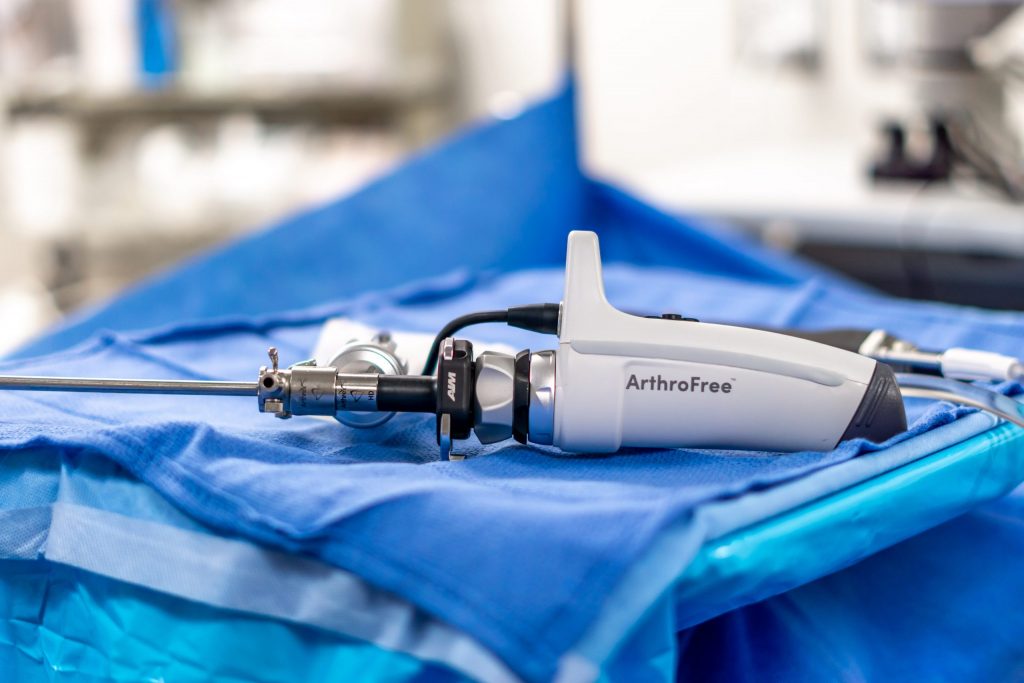Wireless treatment: No-cord cameras help hospital staff quicken surgery process
IN THIS ARTICLE
- Health Care & Life Science Topic
- Jake Piazza Author
By Jake Piazza Thursday, September 14th, 2023

For decades, arthroscopic surgeries have been done with cameras attached to wires and cords.
Co-founder and CEO of Lazurite Holdings Eugene Malinskiy believed that with all the other technological innovations that had occurred, it was time for a wireless surgical camera.
The wireless camera, known as ArthroFree, received FDA approval last year and in January, De La Vina Surgicenter in Santa Barbara became the first healthcare provider in Southern California to use the technology for arthroscopic surgery.
“I really like it and I think it’s just the future,” De La Vina Surgicenter’s Dr. Christopher Proctor told the Business Times. “The way everything’s gonna progress is wireless and so it’s just the next step for all arthroscopy.”
Proctor is one of an undisclosed number of surgeons across the country that use the ArthroFree in surgery, though Malinskiy did say “dozens and dozens” of surgeons have used ArthroFree across the country.
ArthroFree’s utility does not come from it having a higher-quality image than existing cameras. The fact that it can perform all the services that conventional cameras can without being attached to wires and cords revolutionizes surgeries.
“Not having the wires around is really helpful. The staff loves it because it’s quicker to set up and time is money in the OR” said Proctor, who is an investor in Lazurite Holdings. “It’s safer, there’s less injury risk of people tripping over the cords or less problem with the fire.”
ArthroFree is faster because there are fewer physical objects that have to be sterilized prior to surgery. In a study done by the Journal of Orthopaedic Experience & Innovation last year, the wireless Lazurite camera was faster than wire cameras in set-up, take-down and total time in the operating room.
The safety component is a big positive for Proctor and is also where Malinskiy got the inspiration to develop the product. He was watching a surgeon and staff prepare for a surgery and minutes before the operation was going to begin, the physician assistant tripped and fell on a cable.
The staffer ended up being badly injured enough to have to cancel the surgery, leaving Malinskiy with a takeaway that would go on to become ArthroFree.
“Why in 2014, 2015 are there still wires in the operating room?” Malinskiy told the Business Times.
Malinskiy and his team took feedback from surgeons, including Proctor, throughout the developmental process. Lazurite still constantly updates its camera, and for Proctor and a small number of surgeons who have helped the company develop the product, Lazurite sends out the latest model free of charge.
Malinskiy says the cost of doing that is expensive, but the feedback from Proctor and fellow surgeons is so valuable that he believes it is necessary as a token of gratitude.
“It’s all about, number one — saying thank you to the facilities but it’s also for us, making the best product possible,” Malinskiy said.
There were significant obstacles to creating a wireless camera that could be reliably used in the operating room.
For starters, arthroscopic surgeries require a camera with an extremely bright light. A light of that level of brightness often requires a large amount of power, which is not much of an issue when the camera is plugged into an electrical outlet.
However, in order for Malinsky and his team to create their device, they had to have a battery that could make a light that was bright enough and a battery that was strong enough to power the light for a significant period of time.
Now, the ArthroFree comes with three batteries, and each battery lasts one hour.
The camera also had to be able to connect to the receiver without Bluetooth or Wi-Fi, so it uses ultra-wideband, which is also used in military devices. ArthroFree also needed to be light and mobile.
Surgeons do not have to go through any training program to use ArthroFree, Proctor said. It functions similarly to the wire cameras so Proctor was able to apply the same skill set to ArthroFree without any added training.
Even with the product being FDA-approved and in use now, Malinskiy says the road ahead in sales will be tough.
“In some ways, sales may be the hardest thing we will get to do as a company,” Malinskiy said. “If we thought engineering was hard, wait until you do sales.”
email: [email protected]








